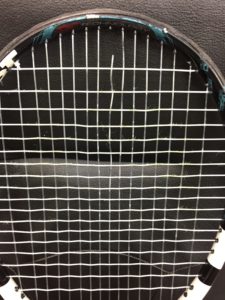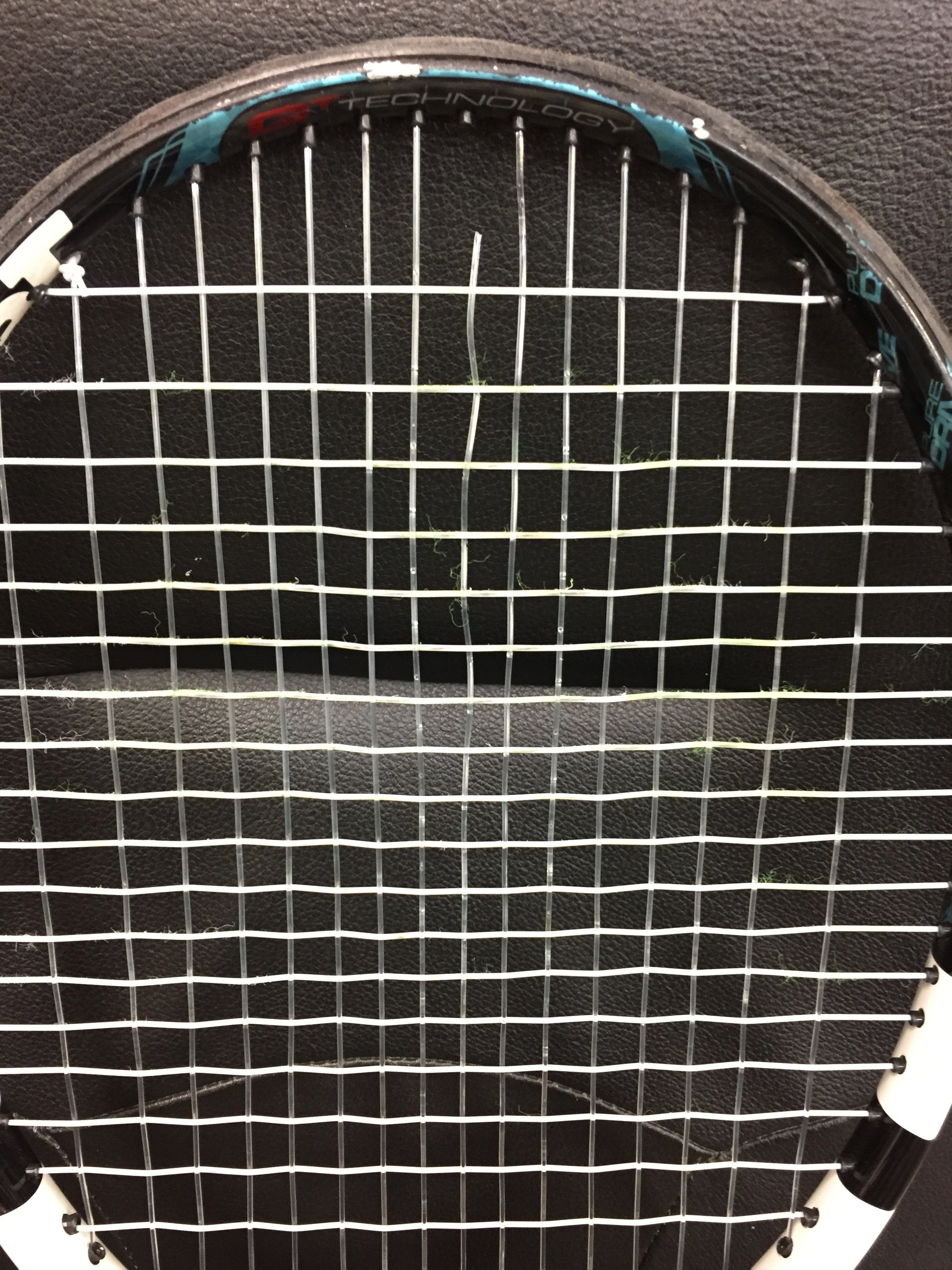Premature string breaks…..Who is to blame?
There are many reasons why strings break. First, ask yourself this question. Is the racquet technician I use reputable and knowledgeable? Not all technicians are created equal. This can make a huge difference if you want a consistent and professional string job. If you’re confident your technician fits this profile, then a brief discussion with him/her might be in order. Consider the following when you talk to your tech:
- Are you using the right racquet for your style and level of play? An NTRP 4.5-player using a super oversize lightweight racquet should set off alarms for your tech that he/she should pick up on right away. Your power level is too high, and the pattern density on the racquet is too open for strings to last much more than 1 set if you’re lucky enough to get that much out of them! The racquet you use DOES make a difference as to how long your strings will last. Want more details on this—ask your technician to explain further.
- Are you using the right string for your style, level of play, and most importantly, the racquet you’re using? Just as above with the racquet, the string should match the player’s ability level and style of play. Likewise, if the string is mismatched to the racquet, this can cause many problems. This is an area that will often separate a knowledgeable technician from a novice.
- Players hitting with a lot of topspin or excessive slice have no business using a thinner gauge string unless they’ve recently won the lottery and can afford to re-string every 6-10 games. Spin causes the strings to move a lot, and if this happens, it means that before long, your strings will begin to notch at the junction where the crosses and the main strings meet. Before you know it, the notch has worn too thin and the string breaks.
-

Mishit at the top of the racquet Framing a ball is probably the most frequent reason for premature string breakage. This is done when the player doesn’t strike the ball in the center of the racquet and instead, hits the ball off the side or top of the frame (see photo at right). Half of the ball is on the frame, and half of it is putting tremendous downward pressure on the grommet where the string enters the frame. NOTHING—I repeat—NOTHING your technician does will prevent your string from breaking if this happens. Don’t try to fool your tech if they ask you if you framed a ball when it happened. A technician who’s worth the money you’re paying them will recognize this as the problem right away. They will have checked the grommets in the racquet and repaired any cracked or worn grommets before they ever strung your racquet, which is another reason for premature string breakage. Cracked grommets or grommets that are broken off flush to the side of the frame will break a string in a heartbeat. If your grommets are good, then the fault is with the player who mishit the ball in the first place—not the person who installed the strings.
- Cheap string is another culprit. If you think you’re saving money by trying to buy your own string, you might think again. By learning to trust your technician and relying on their expertise, you will SAVE money in the long run. I’ve had players come to me who just couldn’t figure out why they were paying someone to string their racquets every other week! As it turns out, they were using a very inexperienced stringer who did nothing but measure the string and install it in the racquet. Their inventory of strings is old, they have mismatched the string for the player and the racquet, or the grommets were cracked so badly that they didn’t stand a chance from the very beginning. The player who thought they were saving money by buying their own string and paying someone less money to install it has actually ended up spending far more money than they ever would have if they had used an experienced technician in the first place.
PLEASE NOTE for (5) above: I see this a lot, and it’s usually parents with juniors who are hitting the ball with excessive spin. Mom and Dad THINK they’re saving money when in reality, that inexperienced stringer is pocketing their money due to his/her ineptitude about the craft of stringing. The sad thing about it is that many times the parents haven’t got a clue as to what’s really going on and think this is normal! An experienced technician with integrity will NOT let this happen!
- Many times, I see players who constantly drag the side of their racquet on the court when going for a low ball instead of bending at the knees to make the shot. This will eventually wear the bumper guard or the side grommet strip down to a point where there’s no protection for the string at all. Sooner or later, when the racquet scrapes the court again, that string is going to break. Again, there’s nothing your technician can do to prevent this. It’s purely due to the player’s technique.
- Old and brittle strings can be a problem as well. When you use a stringer who provides you with one or two choices of string and has a limited inventory, chances are that a good portion of their string has been sitting around for a very long time. The string becomes brittle due to improper storage or too little humidity in the air, and this string is a prime candidate to break too early. Professional technicians maintain a high quality of string in their inventory, which prevents this from ever becoming an issue.
- Racquet abuse is another one on the list. No need to explain anything here. This is obviously not controlled by your stringer.
- Improper storage can wreak havoc with strings. By this, I mean how you care for your racquet while in transit from one location to another. If you plan to play tennis after work and you leave your racquet in the cab of your car or in the trunk in the middle of August, your strings are going to be affected by the extreme temperatures. If pets and children can die from exposure like this, it makes sense that your racquet strings aren’t going to do too well in heat like that either. Also, think about the other extreme when traveling by air. It may be 80 degrees on the ground when your plane departs, but once you reach 30,000 feet, the temperature in the belly of that plane is much colder than you think. Don’t check your racquet with your luggage. If you’re going to take it with you, make sure you include it as a piece of carry-on luggage.
Just remember to be fair. Premature string breaks can be the result of a lot of things that most people are totally unaware of. Before you blame the person who installed the strings in the racquet, try to be objective and look at all of the possibilities.


Comment (1)
On #3, I’ve found it depends on how often you hit. With the polyesters, you are able to go really thin and still have decent durability ( compared to nylon strings). For those that don’t play much, we can get by with the added playability benefits of the thinner polyesters.
In regards to #5, obviously an experienced technician is crucial whether the technician provides the string, or the customer provides it. They should recognize if the string the customer provides might not fit their needs. This happened to me a few days ago when an elderly man brought me a pack of RPM Blast to string in his racquet. He had been drawn in to the string by all the hype, not knowing it wasn’t a good match for him.
In terms of cheap strings, I do think there are TONS of great strings out there that cost a fraction of what the “Big Boys” charge.